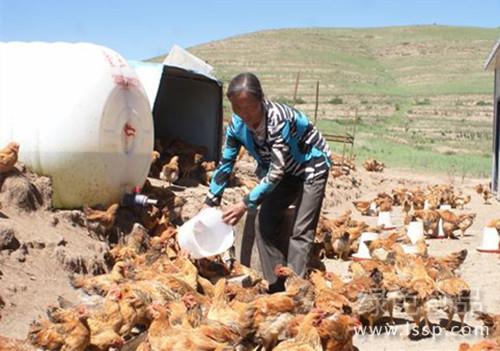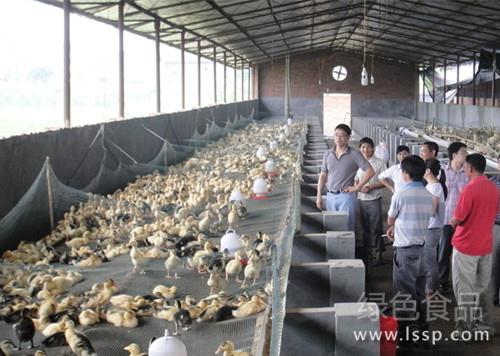Drink more water in summer and many laying hens have peak drinking water requirements in winter.

Chicken drinking water
First, pay attention to the drinking water temperature: open flocks of chickens, water supply, supply is generally in the playground, free-range chicken drinking water appliances are also mostly outdoor. When the summer temperature is high, the drinking fountain should be put in a cool place, the water temperature is slightly lower than the air temperature, avoid exposure to the sun. According to chicken habits, do not like to drink hot water, in contrast, do not refuse to drink lower temperature water. The winter weather is cold, the temperature is low, had better give the chicken to drink warm water, the warm water chicken likes to drink, can also reduce the body heat loss, enhance the cold resistance, is beneficial to the chicken health and laying eggs. The drinking water temperature is not lower than 5 ℃, and 15 ℃ is the best.
Second, drinking water should be hygienic: drinking water should be clean and hygienic, and water contaminated by germs or pesticides should not be used. The drinking water of chickens is standard, and chickens can also use the water that mortals can drink. Factors affecting water quality: water source, reservoir, water appliance, sink, drinking water appliance, chicken with bacteria. Therefore, water appliances should be disinfected regularly. If you use trough water appliances, you should scrub every day. The third floor sink is high and not easy to scrub, so special attention should be paid to it.
Third, timely supply of drinking water: chickens have three peak periods of drinking water every day, that is, 8: 00 in the morning, 12:00 at noon and 6: 00 in the afternoon. Most of the chicken drinking time is in the light time. At about 8 o'clock in the morning, the chickens begin to receive light; around 12:00 at noon, it is the peak time for laying eggs. After laying eggs, the hens consume more water and feel very thirsty, so they need to drink water. At about 6 o'clock in the afternoon, the light is about to end, and they are ready to start resting. Chickens should drink enough water to facilitate their body reserve at night. If the laying hens are unable to drink or do not drink enough water during these three peak periods of water demand, there will be problems with the laying and health of the hens.
Fourth, appropriate supply of drinking water: under normal circumstances, the daily water demand and feed-water ratio of each chicken is about 200 ml in spring and autumn, with a feed-water ratio of 1 to 18; about 270 to 280 milliliters in summer, with a feed-water ratio of 1 to 3; and about 100 to 110 milliliters in winter, with a feed-to-water ratio of 10.9, so the amount of water should be adjusted according to the season. When feeding chickens with dry feed, the amount of water consumed is twice as much as that of feed intake; when feeding chickens with wet material, the amount of water supplied can be less. When the egg laying rate increases, so does the water demand. Because at this time, the chicken laying eggs are exuberant and the metabolism is strengthened, not only water is needed to form eggs, but also the water demand increases with the increase of chicken food intake.
- Prev

The key points of management techniques for keeping ducks in captivity can save labor.
The key points of management techniques for keeping ducks in captivity can save labor.
- Next

The cause of fracture of Chicken tongue Root and its Prevention and treatment
Many chicken farmers use cereal feed to raise chickens in economic forest and have achieved good economic benefits. However, due to the serious shortage of vitamins in cereal feed, when the feeding amount of chickens is large and the range of activity is limited, chickens are often easy to break the root of their tongue because they can not get sufficient supply of green feed. The chicken suffered from anorexia, emaciation and salivation. After opening its mouth, it was found that the root of the tongue was broken and no abnormality was found in other organs. Diseased chickens account for about 15% of the flock. The treatment of the disease is to add multivitamin to the diet of chickens and increase the supply of green feed.
Related
- On the eggshell is a badge full of pride. British Poultry Egg Market and Consumer observation
- British study: 72% of Britons are willing to buy native eggs raised by insects
- Guidelines for friendly egg production revised the increase of space in chicken sheds can not be forced to change feathers and lay eggs.
- Risk of delay in customs clearance Australia suspends lobster exports to China
- Pig semen-the Vector of virus Transmission (4)
- Pig semen-the Vector of virus Transmission (3)
- Five common causes of difficult control of classical swine fever in clinic and their countermeasures
- Foot-and-mouth disease is the most effective way to prevent it!
- PED is the number one killer of piglets and has to be guarded against in autumn and winter.
- What is "yellow fat pig"? Have you ever heard the pig collector talk about "yellow fat pig"?

